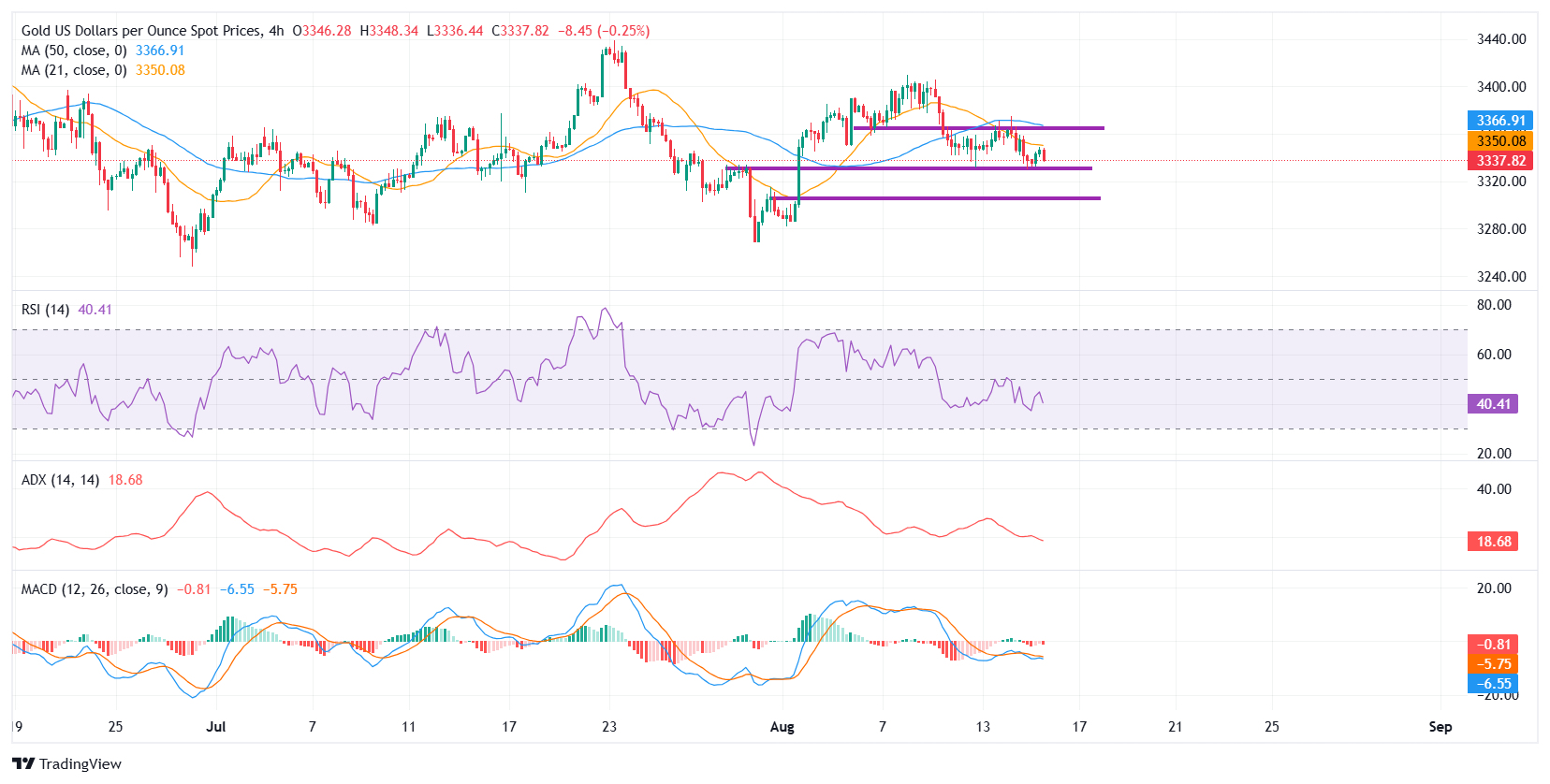- Gold is treading water on Friday, supported by a softer US Dollar, but stays near a two-week low as rising Treasury yields cap gains.
- Markets eye the Trump-Putin summit in Alaska and key US data releases, including US Retail Sales and the University of Michigan Consumer Sentiment Index.
- The technical setup stays bearish, with XAU/USD struggling below $3,350 and momentum indicators pointing to mild downside pressure.
Gold (XAU/USD) struggles to gain traction on Friday, despite a weaker US Dollar (USD), as mixed US macroeconomic data keeps investors cautious. The metal trades in a narrow range near a two-week low, with prices hovering around $3,340 during the American session and struggling to decisively break above the $3,350 resistance zone.
The July Retail Sales report showed headline sales rising 0.5% MoM, in line with expectations but below the upwardly revised 0.9% gain in June. On a yearly basis, Retail Sales rose 3.9%, slowing from 4.4% previously, while the Retail Sales Control Group — a key component feeding into GDP — climbed 0.5%, missing estimates of 0.8%. The slowdown points to a potential weakening in consumer demand, despite ongoing inflationary pressures.
The precious metal is drawing mild bids as investors tread cautiously ahead of the high-stakes US-Russia summit in Alaska. However, a rise in US Treasury yields is capping gains, with stronger-than-expected US Producer Price Index (PPI) data reviving inflation concerns and reducing expectations of large interest rate cuts by the Federal Reserve (Fed), limiting the appeal of non-yielding bullion.
The limited momentum follows Thursday’s drop of over 0.50% to near $3,330, as stronger US inflation data boosted Treasury yields and the US Dollar, weighing on Gold.
Geopolitical risk remains in focus as US President Donald Trump and Russian President Vladimir Putin meet in Anchorage to negotiate a potential Ukraine ceasefire. While markets are not yet showing a significant safe-haven bid, traders remain alert to any developments that could escalate tensions or derail peace efforts. Any breakdown in talks could quickly shift sentiment in Gold’s favor, whereas signs of progress toward peace may weigh on the metal.
Market movers: US inflation and yields climb, China growth slows
- The US Dollar Index (DXY), which measures the Greenback’s value against a basket of six major currencies, is edging lower near 97.90 after Thursday’s rebound. The gauge gained nearly 0.40% in the previous session, supported by hot US producer inflation data, signaling that companies are passing higher import costs from tariffs onto consumers.
- US Treasury yields rebounded across the curve on Thursday, with the benchmark 10-year climbing to trade near 4.302%. The 30-year yield is holding around 4.903%.
- The Empire State Manufacturing Index jumped sharply to 11.9 in August, well above consensus forecasts of zero and up from 5.5 in July.
- Industrial Production in the US contracted by 0.1% in July, missing expectations for a flat reading and marking a notable pullback from June’s 0.4% increase. Meanwhile, preliminary data from the University of Michigan showed a weaker read on consumer confidence. The Consumer Sentiment Index fell to 58.6 in August, sharply missing expectations of 62.0 and down from 61.7 in July. Meanwhile, the Consumer Expectations Index edged up slightly to 57.2, beating the 56.5 forecast but still lower than the prior 57.7 print.
- Risk sentiment had been buoyed earlier in the week by expectations of US monetary easing, with markets fully pricing in a 25 basis-point rate cut in September. However, with US wholesale inflation accelerating in July at the fastest pace in three years, traders have trimmed those odds to about 90%, according to the CME FedWatch Tool.
- According to the US Bureau of Labor Statistics (BLS), July’s US Producer Price Index surged 0.9% MoM — the largest increase since June 2022 — lifting the annual rate to 3.3%. Core PPI, which excludes food and energy, also jumped 0.9% MoM, pushing the yearly rate to 3.7%. Both readings came in well above expectations.
- In an interview with CNBC on Thursday, Federal Reserve Bank of St.Louis President Alberto Musalem said that he expects most of the impact of tariffs on inflation to fade within 6 to 9 months, though it could prove more persistent. He noted that tariffs are feeding through to inflation, and that he has revised his view of labor market risks slightly higher and inflation risks slightly lower. Musalem added that a half-point rate cut is not supported by the current state of the economy or the data.
- Next week’s Jackson Hole Economic Policy Symposium in Wyoming will be closely watched, with Fed Chair Jerome Powell set to speak on August 22. Investors will be listening for his take on the economic outlook and potential policy adjustments, seeking clues on the pace and scale of future interest rate moves amid persistent inflation and shifting market expectations.
- China’s July Industrial Production grew 5.7% YoY in July, down from 6.8% in June and below market expectations for a 5.9% increase. Retail Sales also disappointed, rising 3.7% YoY in July, missing forecasts of 4.6% and slowing from 4.8% in June, underscoring cooling domestic demand in the world’s largest Gold consumer and potentially tempering the medium-term outlook for physical demand.
Technical analysis: XAU/USD struggles below $3,350 amid weak momentum

Gold (XAU/USD) remains under pressure on the 4-hour chart, hovering near the $3,340 mark and struggling to break above the 21-period SMA at $3,350.
Price action is just above the immediate support at $3,330, which aligns with the lower bound of the recent consolidation zone. A decisive break below $3,330 could expose the next downside target at the psychological $3,300 level.
On the upside, the $3,350-$3,355 region is the first barrier, with stronger resistance seen at $3,370, where the 50-period SMA at $3,367 converges with the recent swing high. A sustained move above this level would open the way toward the $3,400 psychological mark.
Momentum indicators show a bearish bias. The Relative Strength Index (RSI) is hovering around 40, signaling mild bearish momentum but no strong conviction. The Average Directional Index (ADX) is subdued at 18.7, indicating a lack of strong trend momentum. The Moving Average Convergence Divergence (MACD) remains in negative territory, with the signal line above the MACD line and muted red histogram bars, pointing to mild downside pressure.
Overall, the technical setup suggests that unless Gold reclaims the $3,350-$3,355 zone, the path of least resistance remains to the downside toward $3,325 and $3,300.

